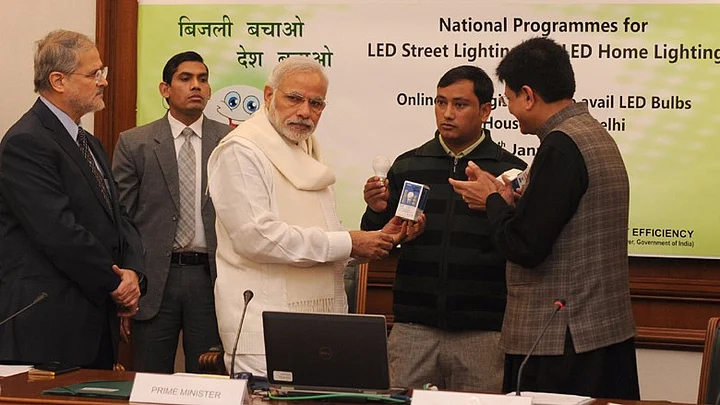In an article titled ‘Why You Shouldn’t Be Bedazzled by Modi’s LED Claims’, The Quint on 21 April published Amitabh Dubey’s fact-check on the Modi-led government’s scheme – UJALA – to distribute millions of low-cost, energy efficient LED bulbs in the country. The author in his article raised doubts about the government’s claims about the financial and energy savings of these LED bulbs, asserting that these are based on “dodgy maths.”
Energy Efficiency Services Limited (EESL), the central government company that is implementing the scheme, sent a clarification on the article on 22 April. The Quint reached out to the author for his rejoinder on the clarification.
EESL’s Clarification on Energy Savings
The state-owned Energy Efficiency Services Ltd. (EESL), disagreed that LED bulb usage should be taken as 3.5 hours/day rather than 8 hours/day, pointing out that the former figure was recommended by the United Nations Framework Convention on Climate Change for carbon credits when actual usage data are unavailable.
The energy savings calculations in BLY and the first set of LEDs programme in 2014 was based on the carbon finance methodology AMS-II. J where the CDM Executive Board of UNFCCC allowed 3.5 hours of usage in case a deemed savings approach was taken, without any monitoring.
EESL in its clarification said that in its DSM and PWC surveys conducted in 35 DISCOMs they found out that bulbs were used for more than 5- 6 hours.
“It is in this context that a conservative estimate of 5 hours has been taken for calculation which is borne out by detailed survey of usage not just in 1 state but across 35 DISCOMs,” they said.
EESL’s Clarification on the Wattage Reduction
Furthermore, it said that an Andhra Pradesh government monitoring survey carried out by “two leading educational institutions” found that actual usage was even higher at 8 hours/day. It said the outcome of the study was:
- Usage hours and energy savings of the installed 7W LEDs that replace 60 W incandescent were recorded and monitored on real-time basis
- RFID/GSM tags are fixed on LEDs that in turn uses a computer chip and antennas to record and transmit real-time measurements to a web enabled system that is remotely accessible
- Original Estimated Operating hours: 3.5 Hrs | Actual Operating Hours: 8 Hrs
- Original Estimated Annual savings: 227 MU | Actual Annual Savings: 381 MU
Therefore, the assumption that the programme translates into savings that are only 36-41 percent of what the government claims is false.
Since EESL has not provided copies of these reports, it is difficult to independently verify these claims. For one, it is erroneous for EESL to state that “5 hours has been taken for calculation” when the original PwC report cited, and available one the government’s UJALA website, clearly states on Table 24 that bulbs are assumed to be operating 8 hours/day, 320 days/year.
It was also widely reported on 21 February 2016 that the Andhra Pradesh government-sponsored study of the districts of Guntur, Anantapur, Srikakulam and West Godavari (the same ones covered by PwC), by Andhra University in Vishakhapatnam and the Hyderabad-based Engineering Staff College of India, found that the actual average energy saving per LED bulb was 73.7 kilowatt hours (kWh), considerably lower than the 133.6 kWh that PwC projected.
Assuming that both reports used the same methodology, this suggests that the actual LED bulb savings are 55 percent of what the government claims.
After the original analysis was published, Twitter user Somnath Mukherjee pointed out that the PwC study assumed an electricity price of Rs 3.50/kWh, which may have further inflated the projected financial savings from LED adoption.
EESL also said that as per the industry statistics, “the 60W incandescent bulb constituted 70% of the volume of bulbs sold and the balance was 100W and 40W having 20% and 10% share” and the replacement would be as under:
- 100W - 9W LED
- 60W - 7W LED
- 40W - 5W LED
The weighted average wattage reduction will work out to 52.3W when all 77 crore incandescent bulbs are replaced. The reduction in peak demand will be 40,271 MW. However, the target has been kept at 50% of the above taking into the consideration that the peak incidence factor of bulbs is 50% - that is during peak time, only 50% of the bulbs are working. Therefore, the target for UJALA for peak demand reduction is 20,000 MW.
Consider the electricity tariffs offered by the Uttar Gujarat Vij Company Ltd in northern Gujarat. Depending on whether you are a rural, urban or “below poverty line” user, your first slab of 50 kWh/month of electricity costs somewhere between Rs 1.50 and 3.50 per kWh; with night-time usage between 10 pm and 6 am attracting a charge of Rs 2.60/kWh.
The true cost of the electricity used by LED bulbs, in northern Gujarat at least, is likely less than Rs3/kWh for the first slab in which the bulk of households will fall, rather than the assumed Rs3.50/kWh. This suggests that savings may in fact be inflated at two compounding levels: (1) the calculation of average use of a bulb and (2) the rupee savings per hour of usage.
To sum up, these inconsistencies need to be clarified, and I look forward to EESL releasing the methodology and findings of the various studies mentioned above. Until then, there is still reason to believe that the government’s projection of savings from LED bulb adoption is based on dodgy maths.
